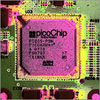picoChip Collaborated With Elliptic on PC3xx PicoXcell SoC Systems
 PicoChip, a developer of WiMax and cellular home basestations(Femtocell) annouced that they have partnered with Elliptic, a leading security-based semiconductor IP supplier, to develop the femtocell architecture with embeded security. Femtocells – small, low-cost basestations that provide enhanced cellular services in homes and offices – present unique security challenges because they are directly connected to operators' networks. So when picoChip was designing its PC3xx picoXcell family of system-on-chip ( SoC ) solutions for the femtocell market, it turned to leading security-based semiconductor IP supplier Elliptic Technologies to help create a secure, standards-compliant architecture.
PicoChip, a developer of WiMax and cellular home basestations(Femtocell) annouced that they have partnered with Elliptic, a leading security-based semiconductor IP supplier, to develop the femtocell architecture with embeded security. Femtocells – small, low-cost basestations that provide enhanced cellular services in homes and offices – present unique security challenges because they are directly connected to operators' networks. So when picoChip was designing its PC3xx picoXcell family of system-on-chip ( SoC ) solutions for the femtocell market, it turned to leading security-based semiconductor IP supplier Elliptic Technologies to help create a secure, standards-compliant architecture.
Because femtocells interface directly with the operator network, they need to be very secure and comply with telecommunications industry standards. These were finalized as recently as March 2009 in 3GPP Release 8, after an accelerated definition process driven by the Femto Forum and 3GPP. Working collaboratively well before the publication of the standards, picoChip and Elliptic crafted a robust security architecture with the power and flexibility needed by OEMs in this fast-changing, evolving sector.
The security standard must accommodate the following aspects:
- Secure backhaul of subscriber voice and data traffic across the public Internet from the femtocell to the operator’s core.
- Accommodation of many different networks and security architectures such as Iuh and IMS.
- Support for securing the wireless traffic, from the mobile device to the femtocell.
- Deployment of a device in the subscriber’s home which could open the femtocell to direct physical attack by hackers.
The standard as finally agreed uses a combination of techniques including IKEv2 ( Internet Key Exchange v2 ) and IPsec ( IP Security ) protocols to authenticate the operator and subscriber and then guarantee the privacy of the data exchanged.
Femtocell design is further complicated due the traffic mix. Cellular network traffic includes a mix of small packets generated by voice calls interleaved with larger packets carrying video, web browser or other data.
To accommodate this diversity the design team elected to integrate multiple security engines into the SoC to support the different modes of wireless and wireline security. As a result, picoChip’s new PC3xx devices significantly outperform competing solutions and can accommodate this challenging mix of traffic.
picoChip has also incorporated a number of system-wide security attributes including ARM TrustZone® technology, secure processor boot and key management capability to ensure that customers’ femtocell designs can be made immune to most attacks.
“The femtocell market is a demanding one,” said Rupert Baines, vice president of marketing at picoChip. “We need to deliver not simply low bill of materials costs and high performance, but also quality, flexibility and standards compliance. Working with Elliptic, with its track record and expertise in security, helped us to create a solution that ticks all of those essential boxes.”
“picoChip gave us the unique opportunity of working with them from the ground up on a new SoC design targeted at the emerging femtocell market,” indicated Richard White, President and CEO of Elliptic Technologies. “This allowed the two teams to implement a rigorous, high-performance security architecture that precisely matches the stringent security requirements in femtocell applications. The successful collaboration between the teams has been very rewarding for all involved and secures picoChip’s leadership position in the femtocell market.”
About picoChip
picoChip is the industry’s leading supplier of femtocell silicon. The company’s picoXcell SoCs crystallize five years’ experience in the field; its picoArray programmable wireless processors are class-leading flexible, programmable solutions for any wireless standard, including GSM, WCDMA, TD-SCDMA, WiMAX and cdma2000.
Related News: